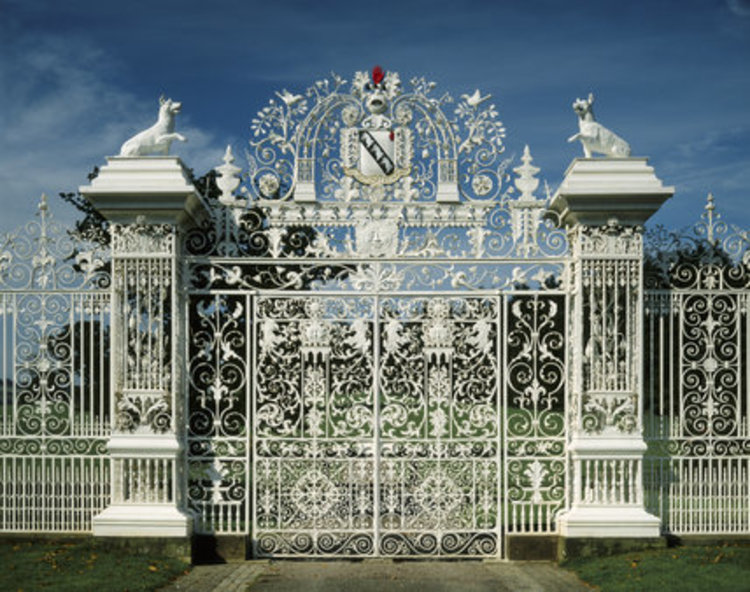A windy day
 I was at an old house, sitting on a chair and looking to the heavy iron gate through which people have to pass to enter the house. Then I saw the gate trembling slowly, in a back-and-forth motion, and I supposed it was because of the air, since that day was very windy. I thought that the situation could turn into an interesting Brilliant problem, so here it is: consider that the iron gate weights 50 kg, has an elastic constant of 50N/m and is a rectangle with dimensions 1.5x2. The wind collided with the gate with a speed of 1m/s and left (instantly) to the other side of it with a speed of 0.9m/s. Considering that the air collided with the whole gate and that the wind blast lasted 1s, what is the frequency, in Hertz, of the gate's vibration? You may take the density of air to be
.
I was at an old house, sitting on a chair and looking to the heavy iron gate through which people have to pass to enter the house. Then I saw the gate trembling slowly, in a back-and-forth motion, and I supposed it was because of the air, since that day was very windy. I thought that the situation could turn into an interesting Brilliant problem, so here it is: consider that the iron gate weights 50 kg, has an elastic constant of 50N/m and is a rectangle with dimensions 1.5x2. The wind collided with the gate with a speed of 1m/s and left (instantly) to the other side of it with a speed of 0.9m/s. Considering that the air collided with the whole gate and that the wind blast lasted 1s, what is the frequency, in Hertz, of the gate's vibration? You may take the density of air to be
.
Details and Assumptions :
-
The whole volume of air collided instantly with the gate. Do consider that air is always suspended in the atmosphere.
-
The vibration is the back-and-forth motion. Consider that the whole gate moves, because it is bound by chains, which let this happen.
-
Answer in decimals.
-
Consider that there was no energy loss to anything that was not part of the system.
Inspiration: A lazy day
Image credit: National Trust Prints.
The answer is 0.25.
This section requires Javascript.
You are seeing this because something didn't load right. We suggest you, (a) try
refreshing the page, (b) enabling javascript if it is disabled on your browser and,
finally, (c)
loading the
non-javascript version of this page
. We're sorry about the hassle.
As the wind blast lasted 1 second, and the air leaves the gate with a speed of 0.9m/s, then the air ran a distance of 0.9m after leaving the gate. Hence, the air volume is the gate's area times the distance the air ran, which creates a prism with dimensions 0.9 x 1.5 x 2, that is 2 . 7 m 3 , and this volume of air weights ( 1 . 2 2 × 2 . 7 )kg, which is 3.294kg. The air's kinetic energy variation can be expressed as Δ E k = E k − E k i = 2 m a i r ( 0 . 9 ) 2 − 2 m a i r 1 2 ⇒ ∣ Δ E k ∣ = 2 0 . 1 9 m a i r = 2 0 . 1 9 × 3 . 2 9 4 = 0 . 3 1 2 9 3 5 J
This energy was transferred to the gate, giving it kinetic energy and elastic energy. The maximum distance the gate can go with this energy can be calculated considering the moment in which all the kinetic energy is converted into elastic energy (when the gate will start to go back to its position):
∣ Δ E k ∣ = E e l ⇒ 0 . 3 1 2 9 3 5 = 2 k x 2 ⇒ 0 . 3 1 2 9 3 5 = 2 5 0 x 2 ⇒ x 2 = 0 . 0 1 2 5 1 7 2 ⇒ x = 0 . 1 1 1 8 8 0 2 9 3 2 m
Note that "k" is the gate's elastic constant, and "x", the distance the gate moved. As the results are starting to get very big (in number of digits, at least), you can finish the calculations using literal symbols, and you'll reach the same frequency. To calculate the frequency, the time is needed. Then, using Torricelli's Equation, the acceleration can be calculated:
v 2 = v o 2 + 2 a Δ S ⇒ x 2 = 2 a x ⇒ a = 2 x x 2 ⇒ a = 2 x
Note that x = v , because the elastic energy is calculated as 2 k x 2 , and the kinetic energy, as 2 m a i r v 2 , so, as k = m (numerically), then x = v . Also, note that v o is the gate's initial speed, when it received energy from the air. Now, using the speed's time function, the time can be calculated:
v = v o + a t ⇒ x = 2 x t ⇒ t = 2 s
As there was no energy loss to any object that didn't make part of the system, the gate would, at least hypothetically, keep this vibration forever, because the elastic energy and the kinetic energy would keep this constant convertion. Also, this time that was found (2s) is the time it takes the gate to make just half of the movement. The other half takes two more seconds. Hence, the motion's period is 4s, so its frequency is 0 . 2 5 H z .